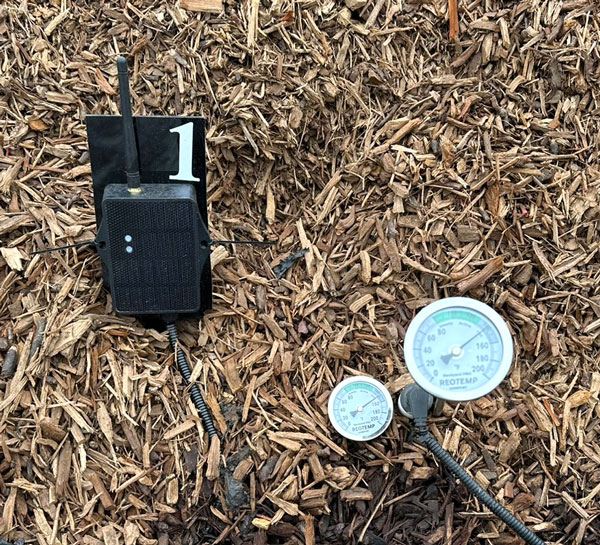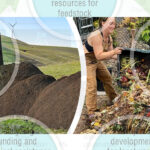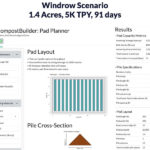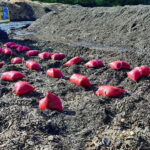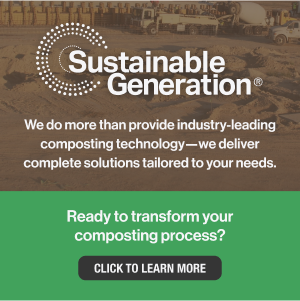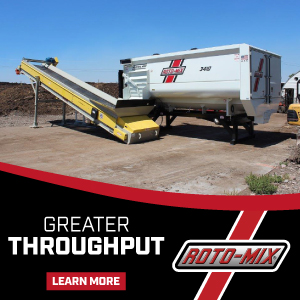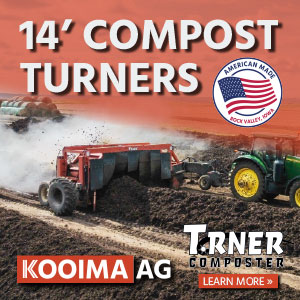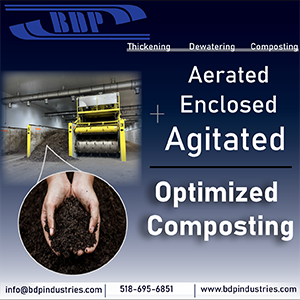Top: Traditional temperature monitoring (main image) and digital temperature probe and transmitter (inset). Photos by Gary Flory
Gary Flory
As highly pathogenic avian influenza (HPAI) outbreaks continue to challenge poultry producers and emergency responders, the need for safer, faster, and more reliable composting practices has never been greater. In 2023, a groundbreaking project in California tested a new remote compost temperature monitoring system — and the results may change how the industry responds in the future.
Meeting USDA Guidelines — Without Risking Worker Safety
When composting is used as a disposal method during an HPAI response effort, the U.S. Department of Agriculture (USDA) guidelines require that compost piles reach and maintain specific internal temperatures to ensure virus inactivation. Temperature must be monitored daily for 28 days, typically using manual probes. These readings are critical for verifying successful pathogen kill, but the process places workers in daily contact with potentially contaminated compost piles. This presents a biosecurity risk and strains the response personnel already working long hours under stressful conditions.
In late 2024, Global Outbreak Solutions partnered with BMP Logic and Central Valley Egg (CVE) in California during an HPAI response to pilot a digital temperature monitoring system. The goal was to compare traditional manual monitoring with a new remote system and assess whether the technology could reduce risk and improve efficiency without compromising regulatory compliance.

Sensors take hourly temperature readings at two depths and transmit them via LoRaWAN to a cloud-based dashboard.
The system used — developed by BMP Logic — relies on SDI-12-compatible sensors installed directly into compost windrows. These sensors take hourly temperature readings at two depths and transmit them via LoRaWAN to a cloud-based dashboard. The dashboard displays real-time temperatures and historical data, generates alerts if temperatures fall out of range, and stores all information in a secure digital archive.
The system was simple to set up. Each sensor draws minimal power, operates independently even in rugged field conditions, and functions reliably across large farms.
CVE Case Study
The CVE project involved a single composting site managing the disposal of thousands of HPAI-infected layer hens. All compost windrows were outfitted with remote digital sensors, and the producer periodically took temperature readings using an analog thermometer to validate the system. The results showed consistent agreement between the digital system and manual checks, with readings typically within one or two degrees. The observed benefits included:
• Worker exposure was reduced by 85%, as daily manual site visits were no longer necessary.
• No holiday labor was required for temperature monitoring, including Thanksgiving, Christmas, and New Year’s.
• Data quality improved, with objective hourly logs replacing potentially inconsistent or missed manual readings.
• Full USDA compliance was achieved, with digital records accepted as sufficient documentation of pathogen inactivation.
Most critically, remote monitoring ensured uninterrupted monitoring with no unnecessary exposure of personnel to potentially infectious material, especially as ensuring worker safety has become increasingly urgent in outbreak zones. Since early 2024, a rising number of human cases of HPAI have been confirmed, particularly among those with occupational exposure to infected poultry and dairy cows. The Centers for Disease Control and Prevention (CDC) has documented over 60 U.S. cases, including infections in farm workers, and global concern about zoonotic transmission is increasing.
Manual compost temperature monitoring requires close and repeated contact with material known to harbor the virus. Reducing these interactions is not only a matter of convenience — it’s a vital health and safety measure. By automating this task, remote sensors can:
- Minimize the risk of virus transmission to workers.
- Reduce liability for producers and contractors.
- Support safer working conditions during multi-week composting efforts.
- Enable better risk management during widespread or simultaneous outbreaks.

A composting site can include a plethora of lengthy windrows. Monitoring temperatures manually opens the door to numerous potential exposure incidents.
Scalable, National Impact For Future Outbreaks
Since February 2022, more than 166.2 million birds have been affected by HPAI across the United States, with outbreaks recorded in all 50 states and Puerto Rico. These have impacted 1,689 flocks, including 781 commercial operations and 908 backyard flocks. The scale and geographic spread of these outbreaks present logistical and biosecurity challenges that strain even the most prepared agencies and producers.
Widespread adoption of digital temperature monitoring could transform how the U.S. responds to future outbreaks. If integrated into composting protocols nationwide, this technology would:
- Standardize data collection across jurisdictions and outbreak types.
- Reduce the number of responders needed on-site, freeing resources for other response functions.
- Shorten response times by enabling remote review and approval of temperature records.
- Build public and regulatory confidence by ensuring consistent, verifiable composting processes.
For the poultry industry, the return on investment grows quickly when considering the labor hours, training, PPE (personal protective equipment), and safety precautions otherwise required for manual monitoring. Agencies at the state and federal levels can also benefit. Remote access to compost temperature data enables oversight without the need for physical inspections, which can be delayed or dangerous during large-scale emergencies. This capability could streamline approvals, improve documentation, and reduce errors in real-time decision-making.
Final Observations
The use of remote temperature monitoring in California showed that composting operations can be made safer, smarter, and more efficient without sacrificing performance or regulatory standards. By reducing daily exposure risks and delivering high-quality, real-time data, this technology represents a practical step forward in both emergency and routine composting.
Composting may be an age-old practice, but the tools we use today can — and should — match the scale of our current challenges. Widespread adoption of remote monitoring systems can enhance the nation’s response capabilities, protect its workforce, and ensure that the composting process continues to be a trusted tool in disease management. It isn’t just a best practice — it’s a necessity.
Gary Flory is the founder of Global Outbreak Solutions and a globally recognized trainer, researcher, and expert in managing transboundary and zoonotic animal disease outbreaks. He advises private industry, national veterinary services, and international organizations such as the UN’s Food & Agricultural Organization, U.S. Department of Agriculture, and World Organization for Animal Health, bringing hands-on experience from over a dozen countries.



